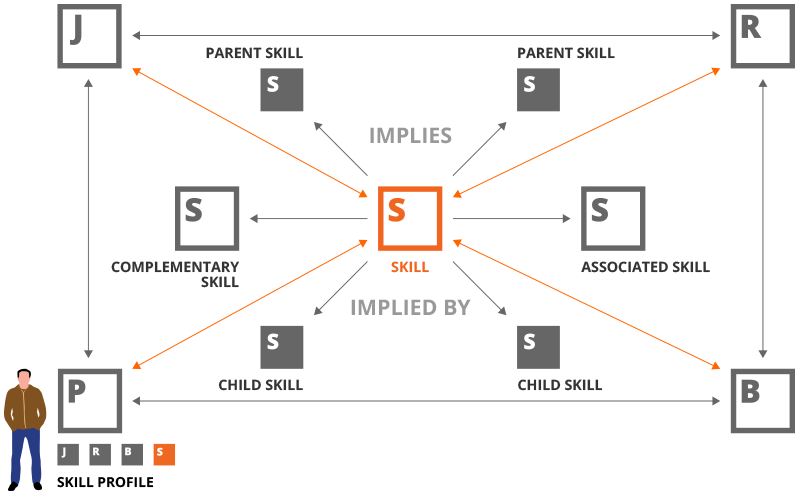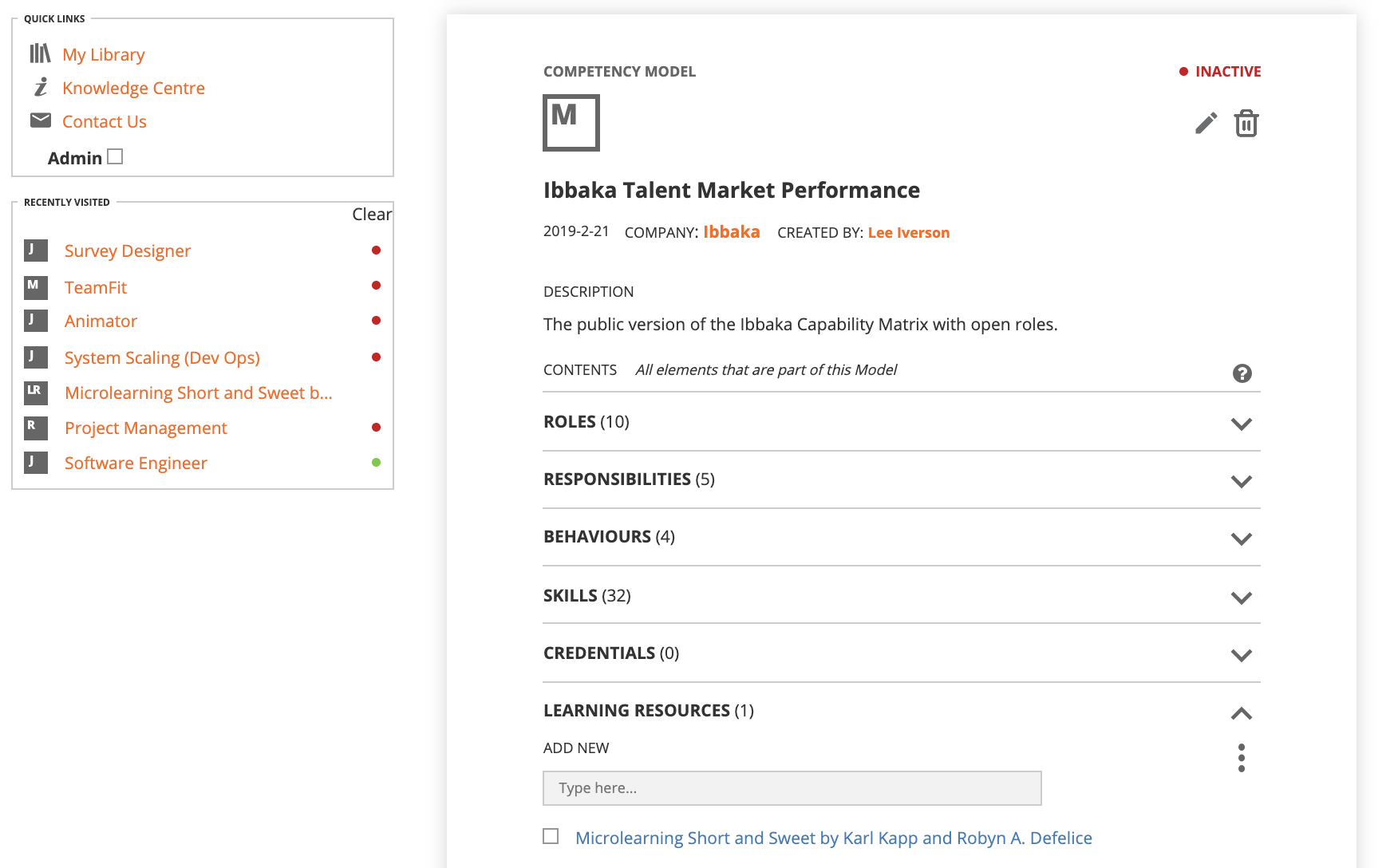Designing the Open Competency Model Architecture
Steven Forth is co-founder and managing partner at Ibbaka. See his skill profile here.
Work on the Ibbaka Open Competency Models has been moving forward rapidly, with many conversations and design sessions with people in the community. We are now finalizing the first generation architecture for these models and are looking to you for advice on this. If you want to jump in directly, please go to the survey (it has only nine questions and should not take more than five minutes. If you would like more context, read on.
Open Competency Models are an important innovation for everyone concerned with building capabilities, improving human performance and realizing the potential of individuals, teams, organizations and professions. These models are open in three ways.
They are offered under a Creative Commons license so that everyone can use and evolve them at no charge.
They evolve over time, and skills actually being used bubble up into the model.
They are modular and on the Ibbaka Talent Platform they can be mixed and matched.
The first four models will be ...
Design Thinking
Customer Success
Pricing Expertise
Adaptation to Climate Change (with the Resilience by Design Lab)
You can find out more about Open Competency Models here.
One of the design decisions we are making is on the general architecture for these models. We want to start with a common architecture, while recognizing that each domain may, eventually need its own design. The design of the Adaptation to Climate Change model will differ from the other three models, so this conversation is about the architecture for the Design Thinking, Pricing Excellence and Customer Success models. Here is a simple sketch of the design choices we are considering.
Let’s work through these one element at a time.
Jobs
Open Competency Models are not intended to be Job Architectures so why include Jobs in the model?
Many people still think of work in terms of Jobs, and including a few example Jobs can make a competency model much more relevant for people. Additionally, one use of competency models is to describe jobs, so having some examples of how a Job is built from the underlying components can be a helpful guide.
Roles
Roles are emerging as a central component in competency models. Roles show up in work in several different ways. Jobs are composed of Roles. One can have a role (or roles) on a project team. One may play a role in an organization that is separate from one’s formal job, and of course we all play many different roles for other people. Including Roles in competency models is a best practice.
Just as a competency is often built from multiple skills and behaviors, there are different ways to describe roles. Three candidates are Competencies, Responsibilities and Tasks.
Competencies or Responsibilities or Tasks
We have not made a final decision on this intermediate, or connective, layer between Roles and Skills. The conventional way to do this is with Competencies. As noted above, one way to think of competencies is as combinations of Skills and Behaviors. To have the competency of Design Thinking, I need a wide range of skills (from Prototyping to Brainstorming, to User Research, to Problem Framing) and I need to exhibit the Behaviors of Seeking New Solutions, Listening to the Community, Empathising with Participants and so on.
So why not just use competencies? We believe that the future of work includes people having more agency, being more responsible for the work that we do and its outcomes. Setting out Responsibilities may be one way to support this. As the Ibbaka Talent Platform has the intelligence to aggregate and connect skills and find patterns, Competencies may turn out to be an optional component of limited use. Responsibilities is a more powerful way to organize competency models.
Given we have the option of using Competencies and Responsibilities, why even consider Tasks? Well, one use of Ibbaka is to connect skills to performance, and we have found Tasks to be one way to get to this. Knowing what tasks are part of a project role and how well they are being performed helps draw the connection between Roles, Skills and actual performance.
Another reason to consider Tasks is for integration with project management systems, like Asana, Basecamp or Wrike. Ibbaka is used as the system of record for skills at a number of organizations, and we pay attention to how we can integrate deep in our design thinking.
Behaviors
Many competency models include behaviors and we are planning to have them in our base architecture for Open Competency Models. Behaviors are something that we can observe in other people an ourselves. If one has a skill, but does not apply it, one is not really competent. In disciplines like Customer Success and Design Thinking, it is important to give guidance on the behaviors expected.
Skills
Skills are the foundational level of the Ibbaka Talent Platform. We use it as a bit of a catch all for both skills and knowledge, and we have a flexible way of categorizing and tagging skills. We even have a skill graph that provides a lot of the intelligence in our system.
Ibbaka Talent Skill Graph
Jobs / Roles / Behaviors / Skills / Learning Resources / Credentials
The Ibbaka Talent AI is able to infer real and potential skills from this graph.
By comparing skill requirements for roles and teams skill gaps can be found.
Resources
One of the key use cases for a competency model is to provide access to learning resources. These resources can come in many forms and we are still building our taxonomy here. Some of the resources we plan to support are as follows:
People who are working to develop the skill
Coaches able to provide guidance
Mentors who have higher levels of expertise
Courses
Self paced online learning
Microlearning
MOOCs
Courses at educational institutions
Communities
Online
Meetups
Online resources
Books
Videos
Tools that include support for learning
A Note on Values
There has been a great deal of discussion about the role of values in competency models. Given the importance of these models and the role they will play in developing new capabilities this is an important question. We will be including values in the Open Competency Models but not in the first release. We need to make some changes to our data model and to have more conversations on what the values should be and how this should work. Please reach out to us at info@ibbaka.com if you are interested in contributing to this.
A simpler approach
At Ibbaka we believe in drinking our own Champagne, and we have a constantly evolving model of the capabilities we use in our own work. For internal use, we have the following competency model architecture.
Jobs (used for external Job Postings)
Roles (these are where we focus, people take many different roles at Ibbaka, and we use the roles to help organize project teams and make sure we have the rights skills on teams)
Responsibilities (helping people understand what is expected of each role has a big impact on performance)
Skills (the atomic level of our system where a lot of its intelligence lies)
Resources (information about people, groups, tools, learning that can help with the Skill and Role)
If you are looking closely, you can see that the model also includes Credentials. This is something we are experimenting with as several people at the company are pursuing various different credentials and we want to celebrate this.
There is an even simpler approach. One can limit a model to just Roles and Skills. We find that having the intermediate construct of Responsibility helps clarify the competency model and make it more useful. On the other hand, we have found simple lists of skills to be much less useful.
Ibbaka Posts on Competency Models and Competency Frameworks
From user experience to competency model design - Margherita Bacigalupo and EntreComp
Competency framework designers on competency framework design: The chunkers and the slice and dicers
Competency framework designers on competency framework design: Victoria Pazukha
Design research - How do people approach the design of skill and competency models?
The Skills for Career Mobility - Interview with Dennis Green
Lessons Learned Launching and Scaling Capability Management Programs
Talent Transformation - A Conversation with Eric Shepherd, Martin Belton and Steven Forth
Competency Models Made Easy - Two Simple Spreadsheets to Build Your Own Competency Models
Individual - Team - Organizational use cases for skill and competency management
Designing the Open Competency Model Architecture (this post)
Co-creation of Competency Models for Customer Success and Pricing Excellence
Competencies for Adaptation to Climate Change – An Interview with Dr. Robin Cox
Architecting the Competencies for Adaptation to Climate Change Open Competency Model
Integrating Skills and Competencies in the Talent Management Ecosystem
Organizational values and competency models – survey results





